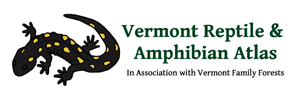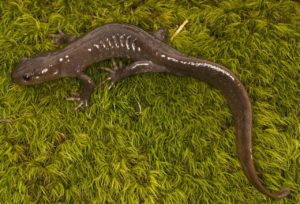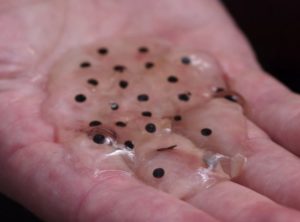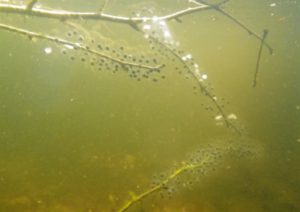Ambystoma jeffersonianum
Identification
 The Jefferson Salamander is one of Vermont’s three mole salamanders. Mole salamanders spend most of their lives underground (like moles) except when migrating to and from breeding pools and ponds. They grow to 7 inches long. This species has a solid gray-brown body with tiny white flecks on the belly and lower sides. It is a chunky salamander with strong legs, a wide head, and a laterally-compressed tail (like a fish). The head and snout are wider and longer in this species than in Blue-spotted Salamanders but not as wide as the head of the Spotted Salamanders. They usually lay their eggs in sausage-shaped gelatinous masses of 10-30 eggs. Unlike Spotted Salamander egg-masses, Jefferson Salamander masses tend to not hold their shape when out of the water.
The Jefferson Salamander is one of Vermont’s three mole salamanders. Mole salamanders spend most of their lives underground (like moles) except when migrating to and from breeding pools and ponds. They grow to 7 inches long. This species has a solid gray-brown body with tiny white flecks on the belly and lower sides. It is a chunky salamander with strong legs, a wide head, and a laterally-compressed tail (like a fish). The head and snout are wider and longer in this species than in Blue-spotted Salamanders but not as wide as the head of the Spotted Salamanders. They usually lay their eggs in sausage-shaped gelatinous masses of 10-30 eggs. Unlike Spotted Salamander egg-masses, Jefferson Salamander masses tend to not hold their shape when out of the water.
This species has produced hybrids with the Blue-spotted Salamander; consequently, some individuals can be hard to identify.
Get more detailed identification and life history information by downloading the chart here.
You can learn more about this species and see some video footage by checking out this clip from our Rattlers, Peepers & Snappers DVD.
Range/Habitat

[ click image to zoom | download printable PDF ]

[ click image to zoom | download printable PDF ]
Jefferson Salamanders are found scattered in low hilly regions of the state, in upland forests near semi-permanent pools. They are sensitive to acidity in their breeding pools, so they are found in areas with soils and bedrock that can buffer the effects of acid rain.
Status
This species has a state natural heritage rank of S2 (rare) and is a species of special concern in Vermont. The Jefferson Salamander has been designated a Species of Greatest Conservation Need (medium priority) in Vermont’s Wildlife Action Plan. Please report all sightings of this species in Vermont. Take photos if possible. Even historic sighting information is useful.
Additional Images
More Info
- Ambystoma jeffersonianum at Animal Diversity website
- Ambystoma jeffersonianum at Amphibiaweb
- Ambystoma jeffersonianum at the Canadian Herpetological Society website
- Ambystoma jeffersonianum in the Vermont Agency of Natural Resources’ Wildlife Action Plan: Amphibian & Reptiles (9/25/2015 draft)
- Ambystoma jeffersonianum at the Yale Peabody Museum of Natural History website
Species summary written by Ariel K. McK. Burgess.







